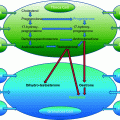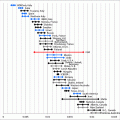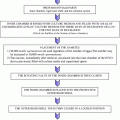Fig. 14.1
Protocol for minimal stimulation and natural cycle IVF. GnRHa GnRH agonist, OR oocyte retrieval, ET embryo transfer, Cryo cryopreservation
Method for Determining the Oocyte Retrieval Period
After confirming follicular growth, the date and time of oocyte retrieval is determined. The ovulation period is estimated from hormone levels; oocytes must be retrieved immediately before ovulation. However, doing so requires an understanding of physiological hormone dynamics and the mechanisms of ovulation (Fig. 14.2). The most important point is the LH level, which varies greatly depending on whether the LH surge has begun. Determining whether the LH surge has begun is the most important point in oocyte retrieval in natural and minimal stimulation cycles. This is done by an appropriate combination of the following methods: (1) direct assessment based on LH levels on the day of examination; (2) assessing whether LH levels have increased based on previous LH levels (including basic values) from the same cycle; and (3) the assessment based on hormone dynamics from the previous cycle. If the LH surge has not begun, GnRH agonist nasal spray is administered between 11:00 PM and 2:00 AM on the day of examination. In accordance with hormone levels, oocytes are retrieved 32–34 h following nasal spray administration (in the morning on day two following administration). If the LH surge has already begun, one of the two courses of action is taken. If the LH surge has only just begun, GnRH agonist nasal spray is administered immediately following examination; in accordance with hormone levels, oocytes are then retrieved 24–30 h following nasal spray administration (in the daytime on the day following administration). In this instance, if the examination is in the afternoon, it is not possible to secure sufficient time from nasal spray administration to oocyte retrieval; this situation results in an inability to retrieve oocytes at the ideal time. If the time has passed since the beginning of the LH surge, oocytes are retrieved within 24 h following nasal spray administration (the morning of the following day). There are also some cases in which the LH surge has already ended by the time of examination. In such cases, ovulation is predicted to occur that same day, making it necessary to retrieve oocytes that day (the day of examination) (Fig. 14.3).
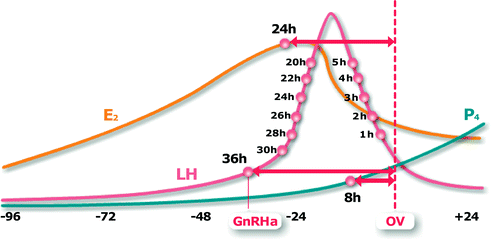
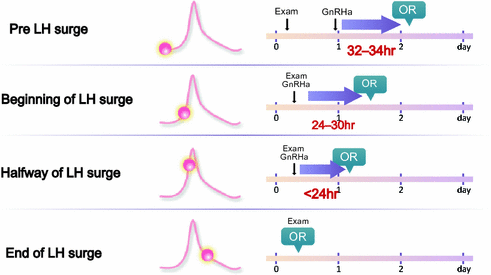

Fig. 14.2
Diagram of LH surge and timing of ovulation. OV ovulation

Fig. 14.3
LH surge and the appropriate timing of oocyte retrieval
Attempts to Prevent Ovulation
As already stated, the most important thing in natural cycles and minimal stimulation cycles is determining an appropriate timing of oocyte retrieval. If the timing is too late, ovulation will have already occurred; if the timing is too early, only vacuoles or immature oocytes will be collected. Therefore, it is necessary to determine how to adapt to the contradiction of securing time until the oocyte maturation while ensuring retrieval before ovulation. Factors related to the mechanism of ovulation include Cox-1 and Cox-2; the administration of nonsteroidal anti-inflammatory drugs (NSAIDs) inhibits Cox-1 and Cox-2 activity, thereby making it possible to delay and prevent ovulation. At eight hours and 16 h before the scheduled oocyte retrieval time, 25 mg diclofenac sodium (Voltaren®) is administered as a suppository. Although this cannot be used for patients with bronchial asthma or gastric ulcers, it can be used without side effects in a wide range of cases. Indeed, we confirmed that Voltaren® reduced the rate of natural ovulation and increased the likelihood of obtaining matured oocytes, and consequently, pregnancy rates were improved [5].
Dealing with Polycystic Ovary Syndrome
Polycystic ovary syndrome (PCOS) presents with ovulation disorders; therefore, in many cases, clomiphene dose not work. The simple administration of gonadotropin agents in these patients can easily result in ovarian hyperstimulation syndrome (OHSS), while administration of hCG often leads to even more serious symptoms. This makes the induction of ovulation difficult. For patients with PCOS, particularly patients with younger age, our clinic uses the aromatase inhibitor letrozole as the first choice in order to avoid OHSS. In doing so, we have achieved favorable results in terms of ovulation induction and pregnancy outcomes. Although not possible in principle in natural cycles, alternatively, clomiphene can also be applied. Specifically, a small dose (50–70 IU) of FSH (rFSH) is used concomitantly with clomiphene and administered on alternate days. The dose is then gradually increased as appropriate while confirming follicular growth. Although basic ovulation induction methods are not much different with those for non-PCOS patients, the risk of severe OHSS can be reduced by avoiding hMG administration; determining the timing of oocyte retrieval earlier even follicle size is smaller than normal in case of the large number of follicles that are developed; not administering hCG; and considering cryopreservation of all embryos.
Oocyte Retrieval Techniques
Usually, oocyte retrieval does not require the use of anesthetic. At our clinic, oocytes are retrieved using a 21G (Kitazato, Japan) fine needle, and pain is normally not a problem. The use of a fine needle also reduces invasion into tissue, thereby reducing the risk of hemorrhage and infection following oocyte retrieval.
Protocol for Frozen Embryo Transfer
Fresh embryo transfer is performed on day 2 or 3 after oocyte retrieval at cleavage stage or on day 5 at blastocyst stage. Because transfers are performed following oocyte retrieval, protocol conforms to oocyte retrieval cycles.
When transferring frozen embryos, the protocol differs based on whether natural ovulation is observed. When natural ovulation occurs, thawed embryos are transferred on day 2 at cleavage stage or on day 5 at blastocyst stage following confirmation of natural ovulation. On the scheduled transfer day, hormone testing is performed for all patients, and the transfers are suspended for patients with abnormal hormone levels. Normally, strong progesterone replacement is unnecessary; rather, 30 mg/day dydrogesterone (Duphaston® tablets) is administered for 12 days in case of transfer at cleavage stage or for 7 days in case of transfer at blastocyst stage. When natural ovulation is not observed, a hormone replacement cycle is introduced. The precycle entails the use of norgestrel/ethinyl estradiol (Planovar® combination tablets); the cycle is then begun on day 2 following withdrawal bleeding. Administration of estradiol (0.72 mg Estrana® tape) is begun on day 2. On day 10, the dosage of Estrana® tape is reduced in accordance with hormone levels and endometrial thickness. Concomitant use of Duphaston® and Planovar® is begun on days 11 and 14, respectively. In the case of blastocysts, embryo transfer is normally performed on day 18 (Fig. 14.4).
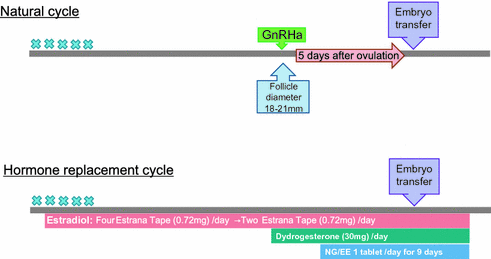

Fig. 14.4
Protocol for embryo transfer. NG/EE Norgestrel/Ethinyl estradiol
Embryo Transfer Techniques
Embryo transfer for all patients consists of single embryo transfer guided by transvaginal ultrasound. When performing selective single embryo transfer, blastocyst culture is performed for surplus embryos; after embryo selection, favorable blastocyst development is confirmed, and the embryos are cryopreserved. Unlike transabdominal ultrasound guidance, the use of transvaginal ultrasound does not require filling of the bladder, thus allowing patients greater comfort. Another merit is that ultrasound and the embryo transfer catheter can be operated by a single operator. The use of transvaginal ultrasound also enables a more detailed observation of the endometrium, thus allowing the embryo to be implanted in a more appropriate location [6].
Comparison of Natural Cycles and Clomiphene Cycles
Clomiphene cycles differ from natural cycles in two major ways: Due to the anti-estrogenic effect of clomiphene, the LH surge does not occur readily, and thinning of the endometrium occurs. Table 14.1 shows LH values at the onset of LH surge in clomiphene cycles and natural cycles at our clinic. For age-groups of <35 years, 35–37 years, 38–39 years, 40–41 years, and 42–45 years, clomiphene cycle LH values were 9.34 ± 0.12, 9.01 ± 0.12, 8.84 ± 0.13, 8.81 ± 0.13, and 9.33 ± 0.11 mIU/mL, respectively, while natural cycle LH values were 19.19 ± 0.86, 18.57 ± 0.93, 14.68 ± 0.90, 13.78 ± 0.94, and 14.31 ± 0.79 mIU/mL, respectively (Table 14.1). Regardless of patients’ ages, clomiphene cycles demonstrated inhibition of the LH surge compared to natural cycles.
Table 14.1
Mean serum LH at the onset of preovulatory LH surge in clomiphene cycles and natural cycles
Age (years) | LH level (mIU/ml) | |
|---|---|---|
Clomiphene | Natural cycle | |
<35 | 9.34 ± 0.12a (n = 887) | 19.19 ± 0.86b (n = 233) |
35–37 | 9.01 ± 0.12a (n = 1293) | 18.57 ± 0.93b (n = 268) |
38–39 | 8.84 ± 0.13a (n = 1203) | 14.68 ± 0.90c (n = 131) |
40–41 | 8.81 ± 0.13a (n = 1409) | 13.78 ± 0.94c (n = 137) |
42–45 | 9.33 ± 0.11a (n = 2287) | 14.31 ± 0.79c (n = 216) |
Comparisons of endometrial thickness at the time of fresh embryo transfer between clomiphene cycles and natural cycles are shown in Table 14.2. For age-groups of <35 years, 35–37 years, 38–39 years, 40–41 years, and 42–45 years, clomiphene cycle endometrial thickness was 10.15 ± 0.06, 10.06 ± 0.06, 9.74 ± 0.05, 9.51 ± 0.05, and 9.27 ± 0.05 mm, respectively, while natural cycle endometrial thickness was 10.52 ± 0.06, 10.23 ± 0.05, 9.84 ± 0.08, 9.72 ± 0.10, and 9.34 ± 0.08 mm, respectively (Table 14.2). Clomiphene cycles demonstrated a tendency toward endometrial thinning compared to natural cycles, with a significant difference observed in the age-group of <35 years. In both types of cycles, the endometrium tended to become thinner with advancing age.
Table 14.2




Mean endometrial thickness on the day of fresh day 2 embryo transfer in clomiphene cycles and natural cycles
Stay updated, free articles. Join our Telegram channel

Full access? Get Clinical Tree



